I recently was able to see an exhibition of the marvelous Derek Buckner’s exhibition at the George Billis Gallery in New York. I was enchanted by his use of light and color as well as the visual drama of his cityscapes and contacted him to see if he would agree to an interview. I’m delighted and thankful for his taking the time for this email interview about his work and background.
Derek Buckner is a Brooklyn, NY based painter who studied at Vassar College, the Art Students League of New York, and the Boston Museum School’s stone-carving program in Carrara, Italy. He received his BFA from the School of the Art Institute of Chicago. He has had numerous solo exhibitions since 2001 and is represented by George Billis Gallery, New York.
LG: You studied at the Art Institute of Chicago with Susanna Coffey and Dan Gustin, who both have a deep involvement with painting from observation. Can you say something about your experience with them?
DB: During my studies at the Art Institute of Chicago both Dan Gustin and Susanna Coffey (as well as my professor Don Southard) had a strong influence on my approach to perceptual painting. Even though their classes were figure painting classes with a live nude model they all encouraged me to move away from focusing on the figure only and really think about the room itself as the subject. This was extremely liberating for me and I found that I was able to explore more complex compositions by incorporating every prop, piece of furniture, paint tube and even fellow students into my paintings.
Larry Groff: I’ve read that your father, Walker Buckner, is a landscape painter who shows at Lori Bookstein Fine Art. How did that influence you?
Derek Buckner: My father has had a strong influence on my painting in different ways. Growing up watching him work gave me a first hand perspective of daily life of being a painter. In many ways this prepared me for life after art school and how to maintain a disciplined practice. I have great memories of waking up early and setting our easels and working side-by-side plein air.
LG: I read where you lived and painted in Baja Mexico for time, how did that come about? Do you still go back there to paint on occasion?
DB: After I graduated from the Art Institute of Chicago in 1994, while on a family vacation to Cabo San Lucas, we heard about a small fishing village up the coast called Todos Santos that was less touristy than Cabo with a budding arts community and great restaurants. My father and I brought our paints hoping to get an afternoon in of sketching and ended up staying for a week exploring the area and painting. I was really inspired by the landscape and light of Baja so I did some research and found a small house for rent for about $80 a month and decided I would stay for a few months and try to develop a series of landscape paintings. Four months turned into about 2 years during which I developed a body of work and coincidentally connected with an art dealer from LA who was able to sell my work to his clients in Cabo and California. I ended up buying a small piece of land and building a modest house which my family and I still visit every winter though not as often as we would like, now that our older kids are in school.
LG: The great Venetian view painters like Canaletto and his student, Francesco Guardi painted scenes of 18th century life along the canals in Venice. Their use of light and color has a visual drama that you don’t often find in their peers. Canaletto’s early masterpiece, The Stonemason’s Yard is perhaps my favorite work of his. I know the Gowanus Canal is a far cry from San Marco but I wonder if these painters might have influence?
DB: I am a big fan of Canaletto! I am particularly drawn to how he juxtaposes the precise details of the Venetian architecture with painterly atmospheric skies. I would definitely say that when walking through the Gowanus area in the evening with the light striking the clouds it is hard not to think of Canaletto. It is one of the few places in New York where the buildings are low enough so that the sky opens up. Though the Gowanus area is an industrial setting there’s something about it that is timeless and classical in many ways. The water of the canal is toxic but also calm and glassy. I find it to be one of the most peaceful settings in New York.
LG: The painterly sensibility of George Bellows’ urban scenes is likely to be a closer influence to your work. What might you say about his work in relation to yours and what other painters have been most influential to you?
DB: George Bellows has had a profound influence on me. He is such a dynamic painter. I am always amazed at his ability to paint with such confidence using a heavily loaded brush. When I find myself becoming too timid with my work, I often look at George Bellows’ paintings, which can help get me out of my rut. There is real grit in his work. I am always inspired by how playful and loose his handling of paint is and yet he never shy’s away from the dirt and grime in his urban scenes.
LG: Do you still have a studio overlooking the Gowanus Canal? How much does the distance of your selection of what to paint from your window come into consideration? Do you ever paint things in far distance as if they were much closer to you?
DB: Unfortunately, I recently had to move out of my Gowanus studio. As you may have heard, the Gowanus area has become very hot real estate and many artists have been either priced out or forced out of their spaces. I now have a studio in Sunset Park. In many ways I am sad to no longer be working near the canal which has been a favorite subject of mine, but at the same time, I’m excited to have discovered Sunset Park with an equally inspiring industrial landscape. Both my previous and current studios have great views. It’s important to me to be able to look out my window and see what the sky is doing at any given moment.
LG: How do you go about starting one of your larger paintings? How much of your work is done on site and what might you say about the importance of observation to your work?
DB: I often start by doing small sketches on site and bring them back to the studio. If I feel like something work on the larger scale I will develop it into a larger painting. Sometimes what works on a small scale doesn’t directly translate to a larger painting so I try not to think of the sketch as defining how the larger painting will ultimately turn out but only as a starting point.
LG: How long do you typically spend on a large painting? Do you paint everyday? What kind of schedule do you keep?
DB: I really like to get to the studio every weekday for at least part of the day. I don’t necessarily need to put in eight hours to feel like I’ve been productive but I do need the consistency of going every day in order to keep a rhythm going. If it’s warm and I can work outside I will, in which case I may only put in two hours of painting in the morning and evening. When I’m working in my studio I keep more of a 9-to- 5 schedule.
LG: Do you use photographic reference in some situations? Do you move elements around or make major changes away from what was in front of you? How important is being faithful to what you see?
DB: For the first 15 years or so of my career as a painter I really only worked directly from life or invented parts of my painting. I was never into to the idea of using photography as a reference for my work mainly because the flatness of the printed photographic image was always pretty uninspiring to me.
It wasn’t until I discovered the iPad that I felt like photography could actually be a useful tool. If there is a subject that I want to paint but I’m not able to work directly from –such as cars on a freeway or a view from an airplane– I will use a digital photographic reference. I’m able to manipulate the image on the iPad get the tonality and color that I am looking for. Even when I am using photography as a reference I tend to only use it sparingly so as not to be too attached to the source image. I often think of painters like Vuillard, Bonnard and Degas who used photography as a tool but were able to keep their paintings alive and fresh and not “photographic”.
I also move elements around in the painting if I feel like something isn’t working. I may get rid of a building or add a tree etc.. For me staying true to “reality” is not a priority and I’ll do whatever I need to do in order to make a painting work.
LG: A number of your paintings show scenes just before dark or perhaps sunrise. What are some reasons for why you choose to paint the light lasting for such a short time? This must be difficult to manage. Can you explain your concerns with regard to painting light?
DB: I am definitely drawn to early morning and late afternoon light. The shadows are longer and the that is when the sky becomes alive. Because the light is changing so quickly at this time I mostly work on small oil sketches to quickly capture the tonality and light of the moment. Sometimes if I’m very familiar with the subject matter I’ll take a larger canvas outdoors but then I’ll bring it back into the studio to refine some of the details and develop the painting further. Like I said earlier, having a view out of my window allows me to work on the skies from my studio as well.
LG: There are a number of painters who explore places like the Gowanus Canal and other industrial wastelands with a variety of approaches which find beauty in toxic, grimy, and filthy surroundings. Often these scenes are just a point of departure and the real painting is more about the formal concerns of compelling color, shape and spatial configurations.
DB: Yes, there are quite a few of us who paint the Gowanus area. I am always amazed at how different artists working with the same subject can end up with such different interpretations and results. My good friend the painter Elizabeth O’Reilly is a wonderful artist who often paints the same scenes that I do and yet she works with such a subtle and delicate palate. She captures the Gowanus Canal so beautifully and yet her work is very different than mine. Another friend of mine, Andrew Lenaghan, does some amazing work of the Gowanus area. He almost exclusively works on site and for this reason he prefers to paint mid day when the light changes the slowest over time.
LG: Do you think there is a risk in making things look too pretty? That the ugliness of a place should be respected and perhaps has compelling visually poetic power in its own terms? To have a respect for things as they are?
DB: In some respects I do think there is a risk of making things look too pretty but also one of the reasons I am drawn to the industrial landscape is because it is visually different than what we see in our usual urban surroundings. The trucks are different, the structures are different, they serve a purpose but often, as onlookers, we have no idea what that purpose is. There is a natural abstraction to the fact that it’s an unfamiliar environment and this keeps things visually exciting.
LG: What would you say to those who think landscape is no longer relevant to today’s artworld? Do you think there is any role for social commentary in landscape painting?
Honestly, I stopped trying to justify whether painting or figurative art or landscape painting is relevant in today’s art world. It happens to be what I love to do and I am drawn to do it–compelled to, really–so for me that’s enough. That’s not to say whether or not it’s “relevant” might not be a legitimate question worth exploring, but it just happens to be one that I’m not so interested in answering anymore. I always come back to landscape and figurative painting as the the most relevant art form. For me it’s hard to imagine being an artist and not wanting to paint the world around me and for that I feel very lucky.

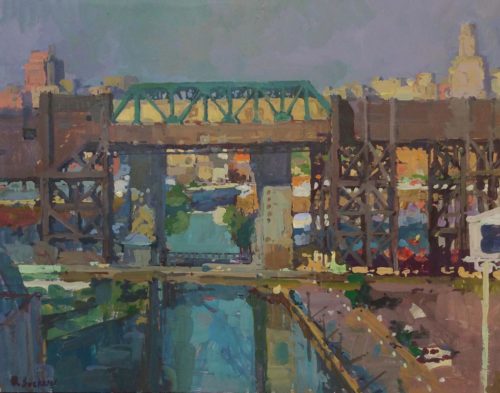
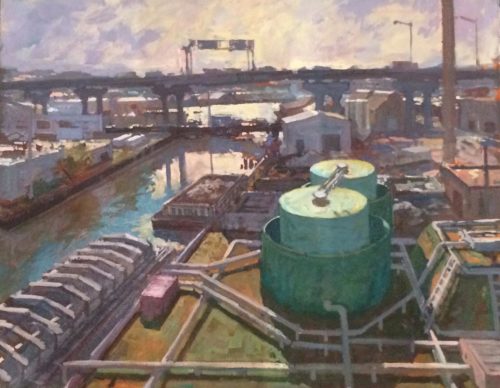
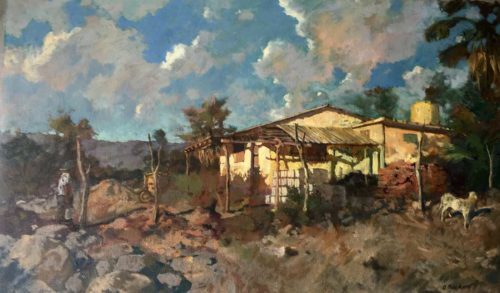
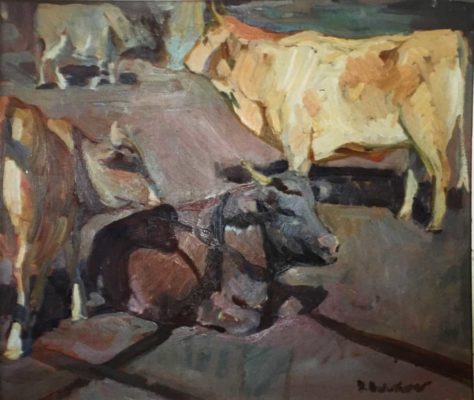
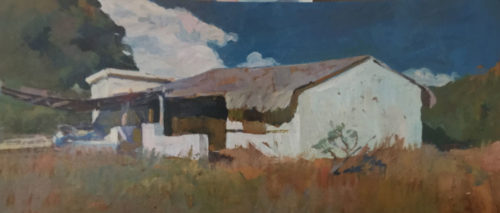
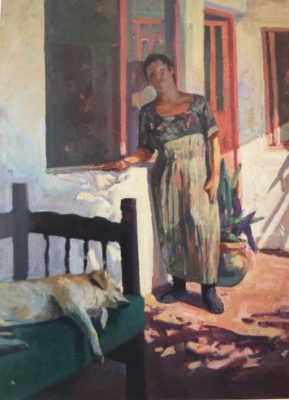
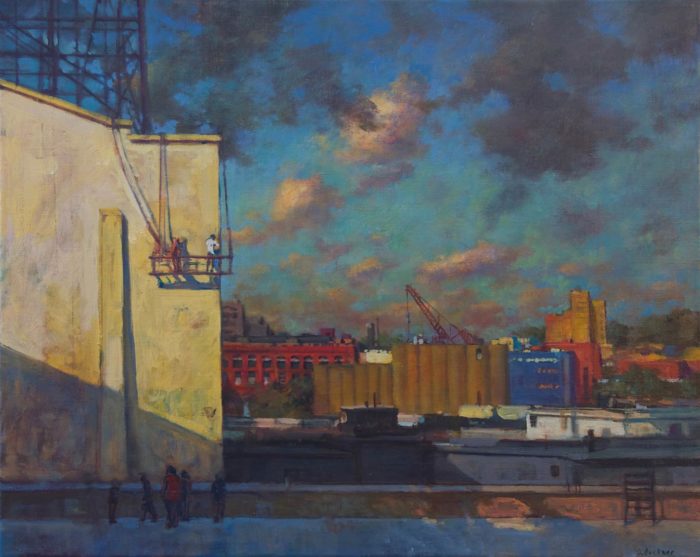
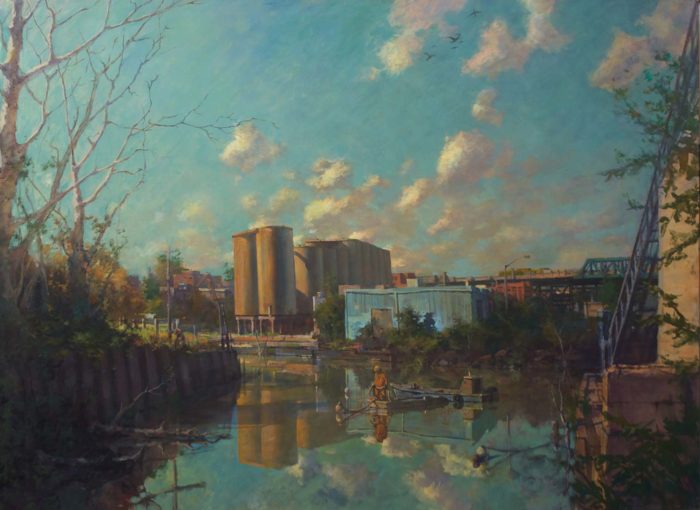
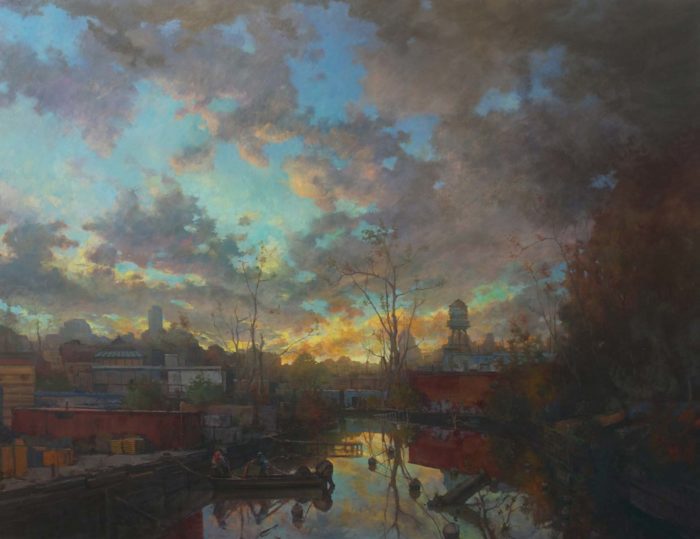
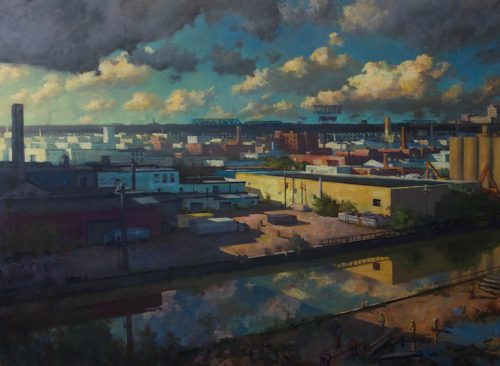
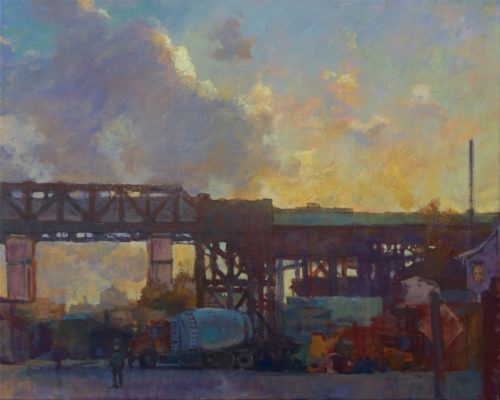

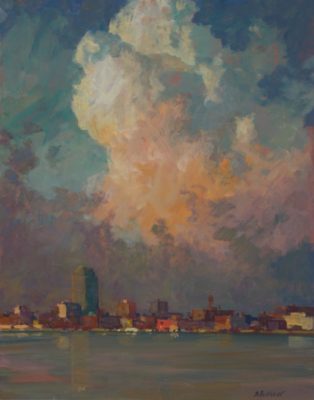
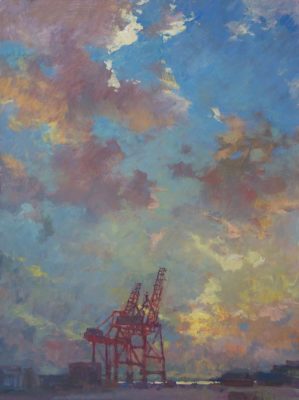

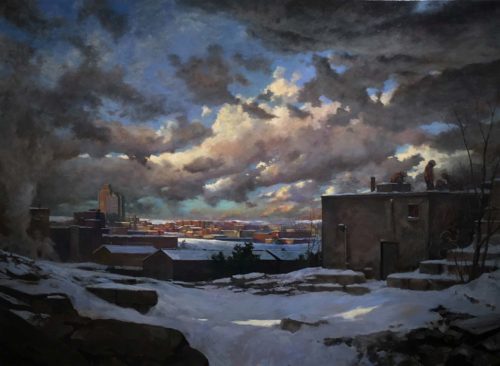
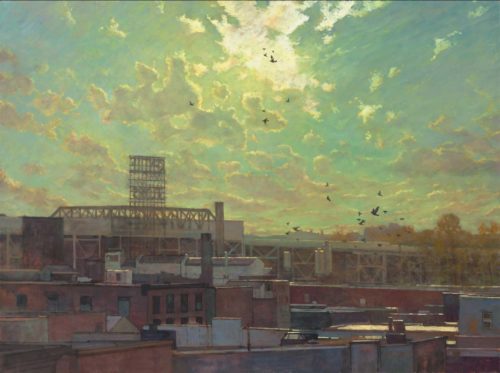

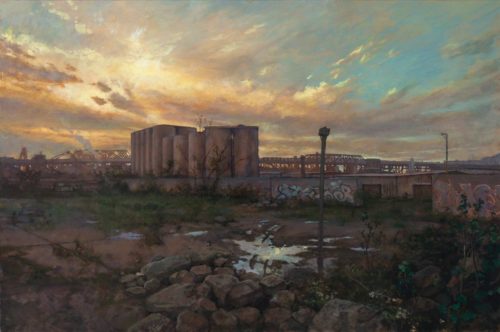
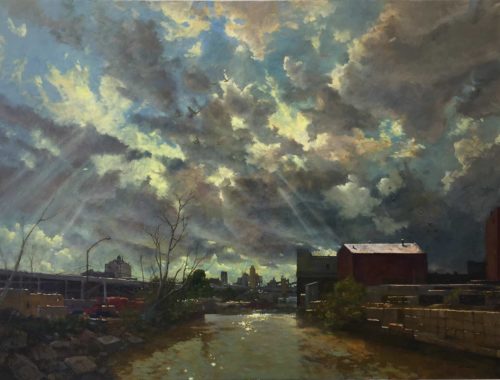
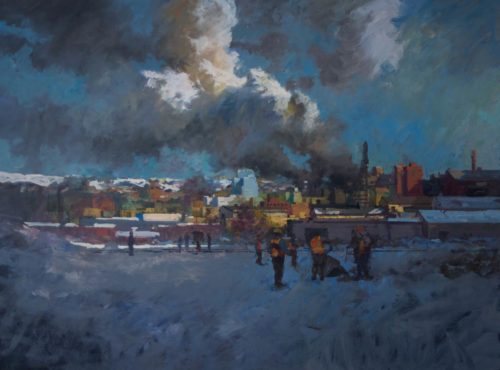
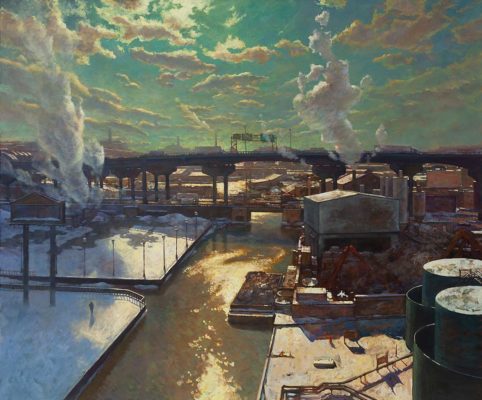
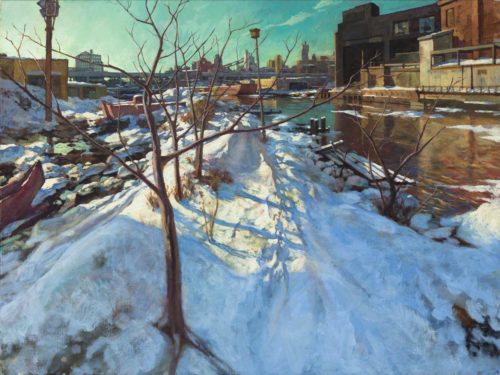




Great interview, Larry. Thanks for focusing on Derek’s work, which I, too, was able to see in person at George Billis Gallery recently. I’m happy to be reminded of it.
Derek, your work is terrific – I was particularly struck by your color and sense of structure. I’m especially drawn to the piece that used gouache, as well, as I love your exploration of lines through the bridge support. Congratulations on the exhibition, and I look forward to seeing your work again!
What a wonderful exchange between two insightful and articulate people. The questions were right on point, and the artist’s replies genuine and illuminating. The interviewer clearly admires the artist’s work, but does not let that interfere with posing the questions that present themselves to the figurative artist. The images are beautiful and aptly inserted within the interview text. Bravo!!!
I found this interview so insightful and Derek’s influences, disciplines and explorations from early childhood
Thank you all for such kind words. It was amy pleasure to have this extended and thoughtful exchange about these marvelous paintings.
I really loved doing this interview with Larry! It gave me a unique opportunity to think and talk about my work and my process as well. Thanks for all the supportive comments!
So appreciated
It’s like blood and oxygen
Vital
Nice to see Derek doing so well.
(from another of Dan and Don’s students at SAIC)